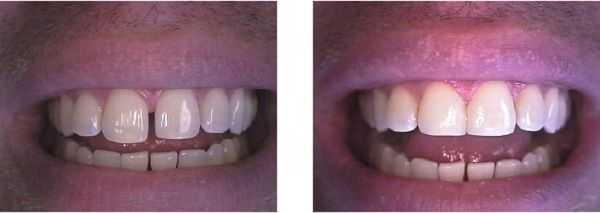A teeth gap or space between teeth is closed with dental bonding in our
Cosmetic Dentistry office. This procedure took about 30 minutes and did not require a shot of novocaine because there was no pain. A diastema is the word used to describe a teeth gap when it is between the two upper front teeth.

This teeth gap was closed with bonding in 30 minutes without the need for novocaine or tooth reduction.
How to close a teeth gap
There are several ways to close a gap between teeth: 1) braces, i.e. orthodontics, 2) porcelain veneers, i.e. dental laminates, or 3) cosmetic dental bonding. Our large group has 16 dentists and specialists including an orthodontist and cosmetic dentists so we can offer our patients all choices within one NY Cosmetic Dentistry office.
There are many more examples of our NY Cosmetic Dentistry throughout this website containing our original content. See the sections on Diastema or Bonding for more pictures.
Close a teeth gap with braces
Braces can be used to move teeth sideways (as opposed to moving them forward toward the lip or backwards towards the tongue). However this type of orthodontic tooth movement requires fixed braces with brackets glued to the teeth and wires attached to them. Removable aligners (Invisalign is one brand of removable aligner) are really not able to move teeth sideways and instead are indicated for inward or outward movement of teeth.
Close a teeth gap with porcelain veneers
Porcelain veneers are an excellent cosmetic dentistry choice to close gaps between teeth when teeth are already also aesthetically damaged and/or discolored. It may be considered an unnecessarily aggressive and costly treatment if the teeth are otherwise aesthetically pleasing. Veneers can typically be placed in two office visits.
Close a teeth gap with bonding
Cosmetic dental bonding is conservative to teeth structure and significantly less costly than porcelain veneers. They are indicated when the teeth are otherwise healthy and aesthetically pleasing, the patient has declined fixed braces and the gaps or spaces are less than the width of one tooth. This procedure is very technique sensitive and relies on significant skill from the individual dentist as opposed to porcelain veneers that are made in a dental lab. Cosmetic dental bonding looks best when it is minimally placed on the facial side of the teeth and instead is mostly placed within the actual spaces or gaps it is being used to close. This is because the natural tooth enamel is therefore left intact and it will subsequently continue to exhibit natural light reflection.
